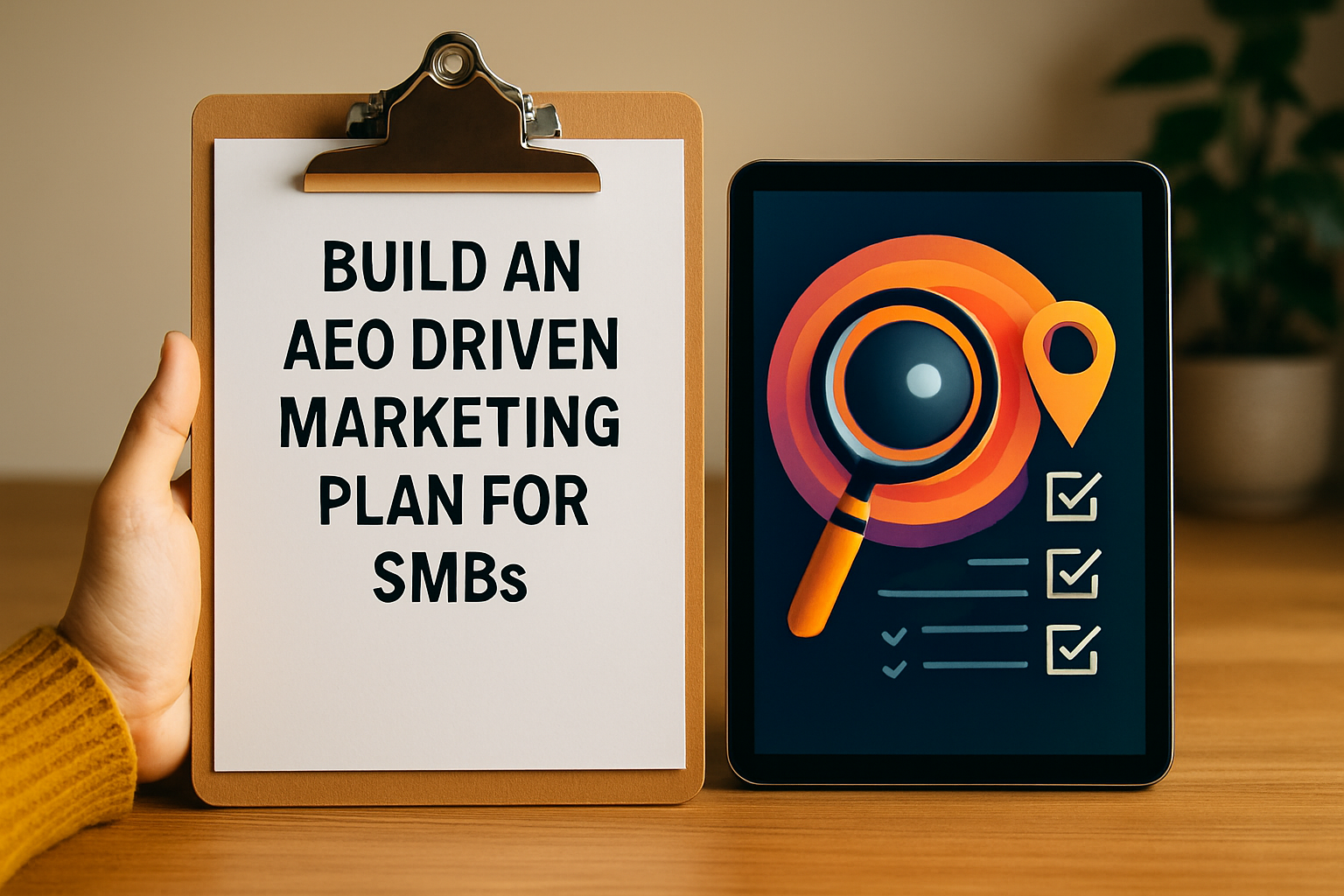Lead Generation Step by Step: Attract More Clients Now

Every successful lead generation strategy starts by understanding exactly who you want to attract. But get this. A Harvard study found that integrated multi-channel marketing approaches can significantly improve customer acquisition and retention, compared to sticking with just one platform. Most businesses focus only on gathering leads, yet forget the real secret is constantly refining your audience and message for every channel you use.
Table of Contents
- Step 1: Identify Your Target Audience
- Step 2: Create Compelling Lead Magnets
- Step 3: Build Effective Landing Pages
- Step 4: Implement Multi-Channel Marketing Strategies
- Step 5: Track And Analyze Performance Metrics
Quick Summary
| Key Point | Explanation |
|---|---|
| 1. Define Your Target Audience | Understand your ideal customer profile to tailor your messaging. This ensures alignment with their needs and preferences for effective marketing results. |
| 2. Create Effective Lead Magnets | Offer valuable resources in exchange for contact information to attract potential clients and showcase your expertise. Focus on solving specific problems for immediate value. |
| 3. Optimize Landing Pages for Conversions | Design focused landing pages that clearly convey value and minimize distractions. A strong call to action and trust elements are essential for higher conversion rates. |
| 4. Use Multi-Channel Marketing Strategies | Employ various communication channels to reach your audience. Ensure consistent messaging across platforms to increase brand visibility and engagement. |
| 5. Track Performance Metrics Regularly | Establish a tracking dashboard to monitor key performance indicators, facilitating data-driven decisions for continuous optimization of lead generation strategies. |
Step 1: Identify Your Target Audience
Successful lead generation starts with a crystal clear understanding of who you want to attract. Your target audience is the foundation of every marketing strategy, defining how you communicate, where you invest resources, and how you craft compelling messages that resonate.
The process of identifying your target audience requires thoughtful research and strategic analysis. Begin by examining your current customer base and looking for common characteristics. What industries do they represent? What challenges do they consistently face? What demographic and professional traits connect them? According to the U.S. Small Business Administration, comprehensive market research helps businesses understand their potential customers more deeply.
Creating Your Ideal Customer Profile
To develop a precise target audience definition, construct a detailed ideal customer profile. This profile goes beyond basic demographics and dives into psychographics – understanding motivations, pain points, aspirations, and decision making patterns. Consider creating a narrative around this persona, giving them a name and specific background to make them feel real.
Start by collecting data through multiple channels: customer surveys, sales team insights, website analytics, and social media engagement metrics. Look for patterns in age ranges, income levels, professional roles, geographic locations, and specific business challenges. For service based entrepreneurs and consultants, this might mean understanding the precise type of professional struggling with lead generation challenges.
Validation and Refinement
Once you have constructed your initial target audience profile, validate it through practical testing. Reach out to existing customers, conduct short interviews, and analyze how well your current marketing messages align with their needs. Be prepared to refine your understanding continuously. Markets evolve, and so should your perception of your ideal customer.
Remember that identifying your target audience is not a one time task but an ongoing process of learning and adaptation. Your goal is to create such a precise understanding that your marketing feels like a personalized conversation, not a generic broadcast.
Below is a checklist table summarizing key steps to validate your target audience, ensuring your marketing efforts are precisely focused and data-driven.
| Checklist Item | Description |
|---|---|
| Create Detailed Persona | Develop a comprehensive profile including demographics and psychographics. |
| Identify Professional Challenges | Pinpoint major challenges your ideal customer faces in their work or industry. |
| Validate with Direct Research | Use customer interviews, surveys, or sales team insights to confirm assumptions. |
| Understand Motivations | Analyze what drives your target audience |
| to make purchasing decisions. | |
| Continuous Refinement | Regularly reassess audience characteristics as markets and behaviors evolve. |

By investing time in this critical first step, you set the stage for more effective lead generation strategies that speak directly to the right people.
Verification Checklist for Target Audience Identification:
- Have you created a detailed customer persona?
- Can you describe your ideal customer’s professional challenges?
- Have you validated your assumptions through direct research?
- Do you understand their primary motivations and decision making factors?
Step 2: Create Compelling Lead Magnets
Lead magnets are the strategic bridge between attracting potential clients and converting them into engaged prospects. These valuable resources offer something meaningful in exchange for contact information, transforming casual website visitors into potential leads. According to the Content Marketing Institute, educational resources are particularly effective in capturing audience attention.
Crafting a compelling lead magnet requires deep understanding of your target audience’s most pressing challenges. The resource must provide immediate, tangible value that solves a specific problem or answers a critical question. This means moving beyond generic content and creating something so useful that potential clients feel they are receiving a premium service for free.
Designing High Value Lead Magnets
The most effective lead magnets are laser focused and solve a specific problem quickly. For service professionals and consultants, this could mean developing a detailed checklist, a concise video training, a customized assessment tool, or a targeted PDF guide that addresses a precise pain point. The key is demonstrating expertise while providing actionable insights that potential clients can implement immediately.
The table below organizes common lead magnet types mentioned in the article, along with their formats and primary benefits for attracting quality prospects.
| Lead Magnet Type | Format | Primary Benefit |
|---|---|---|
| Checklist | PDF/Printable | Quick win, actionable steps for immediate value |
| Video Training | Video | Engaging delivery and demonstration of expertise |
| Assessment Tool | Interactive/Digital | Personalized insights and professional positioning |
| Targeted Guide | PDF/Downloadable | Deep dive into solving a specific problem |
| Audit Template | Worksheet/Checklist | Directly applicable for business improvements |
Consider developing resources that showcase your unique approach and professional perspective. A marketing consultant might create a “Website Conversion Audit Checklist” that helps business owners quickly identify improvement areas. A business coach could design a “15 Minute Productivity Assessment” that provides personalized recommendations. These resources not only capture contact information but also position you as an expert in your field.
Technical Considerations and Delivery
Ensure your lead magnet is professionally designed and easily consumable. High quality graphics, clean formatting, and a seamless delivery process increase perceived value. Use platforms that allow instant digital delivery and integrate smoothly with your email marketing system. This might involve using tools like Leadpages, ClickFunnels, or similar lead generation platforms that streamline the capture and follow up process.
Remember that a great lead magnet is just the beginning. The real magic happens in how you nurture those leads afterward. Design a follow up sequence that continues providing value, builds trust, and gently guides potential clients toward your primary services.

Verification Checklist for Lead Magnet Creation:
- Does your lead magnet solve a specific, urgent problem?
- Have you designed a professional, visually appealing resource?
- Can potential clients get immediate value?
- Does the lead magnet showcase your unique expertise?
- Have you set up an automated delivery system?
Step 3: Build Effective Landing Pages
Landing pages are the critical conversion points where potential leads transform from interested visitors to engaged prospects. These focused web pages must communicate value, inspire trust, and make taking action feel like an obvious next step. According to ConversionXL, strategic design and minimal distractions significantly improve conversion rates.
The most powerful landing pages are laser focused, eliminating navigation menus, external links, and anything that might divert attention from your primary goal. Your entire page should tell a compelling story that guides visitors toward a single, clear action – typically submitting contact information in exchange for your lead magnet.
Crafting a High Converting Landing Page
Start by writing a headline that speaks directly to your target audience’s most pressing challenge. This headline should be bold, clear, and promise a specific benefit. Follow it with a concise subheadline that provides additional context and reinforces the value proposition. Your messaging must instantly communicate what problem you solve and why your solution matters.
Visual design plays a crucial role in building trust and maintaining engagement. Use clean, professional layouts with high quality images or graphics that support your message. Include social proof elements like client testimonials, success statistics, or professional certifications. These trust signals reassure potential leads that you are credible and capable of delivering results.
Technical Optimization and User Experience
Ensure your landing page loads quickly and displays perfectly across mobile and desktop devices. A slow or poorly formatted page will cause potential leads to abandon their journey. Use responsive design principles and test your page on multiple screen sizes. Your contact form should be simple, requesting only essential information. Each additional field reduces conversion likelihood, so ask for the minimum details needed to follow up effectively.
Consider integrating strategic psychological triggers that motivate action. Limited time offers, clear value propositions, and straightforward calls to action can create a sense of urgency. Make submitting the form feel like an opportunity, not an inconvenience. Your design should guide the visitor’s eye naturally toward the conversion point.
Verification Checklist for Landing Page Effectiveness:
- Is your headline compelling and benefit focused?
- Have you minimized distractions?
- Does the page load quickly on all devices?
- Have you included trust building elements?
- Is your call to action clear and prominent?
- Have you tested the page across different browsers and devices?
Step 4: Implement Multi-Channel Marketing Strategies
Multi-channel marketing transforms lead generation from a single approach to a comprehensive, interconnected strategy that meets potential clients wherever they are. Instead of relying on one communication method, you create multiple touchpoints that increase visibility, trust, and engagement. According to Harvard Business Review, integrated marketing approaches significantly improve customer acquisition and retention.
Successful multi-channel strategies require understanding your target audience’s preferred communication platforms. This means going beyond traditional marketing and creating a seamless experience across digital and offline channels. Your goal is to provide consistent messaging that feels personalized and relevant, regardless of where potential leads encounter your brand.
Strategic Channel Selection and Integration
Begin by mapping out the platforms where your ideal customers are most active. For service professionals and consultants, this might include a combination of LinkedIn professional networking, targeted email campaigns, strategic social media content, podcast appearances, and focused webinar presentations. Each channel should support and reinforce your core marketing message while offering unique value.
Digital platforms provide incredible opportunities for targeted outreach. LinkedIn allows precise professional targeting, Facebook enables detailed demographic advertising, and Instagram offers visual storytelling opportunities. Email marketing remains a powerful direct communication tool, especially when segmented and personalized. The key is creating content that feels native to each platform while maintaining a consistent brand voice and value proposition.
Tracking and Optimization
Implementing multi-channel marketing requires robust tracking and analytics. Use tools that provide comprehensive insights across different platforms, allowing you to understand which channels generate the most qualified leads. Google Analytics, marketing automation platforms, and channel specific analytics can help you continuously refine your approach. Pay attention to metrics like engagement rates, conversion percentages, and cost per lead acquisition.
Remember that multi-channel marketing is not about being everywhere but being strategic. Quality always trumps quantity. Focus on channels where you can consistently produce high value content and meaningfully engage with potential leads. Your messaging should feel like a natural conversation, not a pushy sales pitch.
This table provides a concise checklist for multi-channel marketing implementation based on the article’s recommended verification steps.
| Checklist Item | Purpose |
|---|---|
| Identify 3-4 Channels | Focus efforts on the most relevant platforms |
| Ensure Messaging Consistency | Build trust and reinforce your brand identity |
| Track Channel Metrics | Measure effectiveness and optimize performance |
| Develop Platform Strategies | Tailor content to each channel’s strengths |
| Articulate Channel Value | Understand what each channel brings to your campaign |
| Test and Refine Regularly | Continuously improve strategy based on results |
Verification Checklist for Multi-Channel Marketing:
- Have you identified at least 3-4 relevant marketing channels?
- Does your messaging feel consistent across platforms?
- Are you tracking performance metrics for each channel?
- Have you created platform specific content strategies?
- Can you clearly articulate the unique value of each channel?
- Are you continuously testing and refining your approach?
Step 5: Track and Analyze Performance Metrics
Measuring lead generation performance transforms guesswork into strategic decision making. Without precise tracking, businesses waste resources on ineffective strategies. According to Google Analytics Academy, defining and monitoring key performance indicators is crucial for understanding marketing effectiveness.
Performance tracking goes beyond simple numbers. It requires a holistic view of how potential leads interact with your marketing ecosystem. This means understanding not just how many leads you generate, but the quality of those leads, their progression through your sales funnel, and the ultimate return on your marketing investment.
Essential Metrics for Comprehensive Tracking
Start by establishing a dashboard that captures critical lead generation metrics. Focus on indicators like conversion rates, which reveal the percentage of visitors who become actual leads. Cost per lead is another crucial metric that helps you understand the financial efficiency of your marketing channels. Track the source of each lead to identify which platforms and strategies deliver the most valuable prospects.
Qualitative metrics are equally important. Look beyond raw numbers and examine engagement depth. How long are potential leads staying on your landing pages? What percentage of leads move from initial contact to a meaningful conversation? These insights help you refine your approach and identify potential bottlenecks in your lead generation process.
Tools and Continuous Optimization
Leverage analytics platforms that provide comprehensive insights. Google Analytics, HubSpot, and specialized lead tracking software can help you create a robust monitoring system. These tools allow you to set up custom dashboards, track individual lead journeys, and understand the nuanced interactions that lead to successful conversions.
Remember that metric tracking is not a one time activity but an ongoing process of refinement. Set up regular review cycles where you analyze performance data and make strategic adjustments. Be prepared to experiment, pivot, and continuously improve your lead generation approach based on concrete evidence.
Verification Checklist for Performance Metric Tracking:
- Have you established a comprehensive tracking dashboard?
- Are you monitoring both quantitative and qualitative metrics?
- Can you calculate your current cost per lead?
- Have you identified your most effective lead generation channels?
- Do you have a system for regular performance review?
- Are you prepared to make data driven adjustments to your strategy?
Ready to Streamline Your Entire Lead Generation Process?
Feeling overwhelmed by the constant need to find, nurture, and convert new clients, even after following every step from identifying your target audience to tracking complex performance metrics? Most service-based entrepreneurs struggle with scattered tools and time-consuming tasks, making it hard to scale lead generation without burning out. The frustration of losing valuable leads due to slow follow-up or messy systems is real—and it can hold your business back from consistent growth.

What if you could automate every step, from capturing quality leads to nurturing them with personalized sequences and collecting feedback automatically? Authority Echo was built for businesses like yours. Explore how our platform unifies lead generation, automated nurturing, and seamless payment processing so you spend less time on manual work and more time closing clients. Visit our main site now to see immediate results in higher conversion rates, faster responses, and effortless growth. Try Authority Echo today and transform your entire client attraction system in one move.
Frequently Asked Questions
What is lead generation and why is it important?
Lead generation is the process of attracting and converting potential clients into interested prospects. It is crucial because it lays the foundation for sales by identifying individuals or businesses who may benefit from your services or products.
How can I identify my target audience for lead generation?
To identify your target audience, analyze your current customer base for common characteristics, such as demographics, industries, and pain points. Create an ideal customer profile that includes motivations and decision-making patterns, and continuously validate your findings through research and customer feedback.
What are effective lead magnets I can create?
Effective lead magnets are valuable resources that solve specific problems or answer critical questions for your audience. Examples include checklists, video trainings, assessment tools, or targeted guides that showcase your expertise and provide immediate value to potential clients.
How can I optimize my landing pages for better conversion rates?
To optimize landing pages, focus on a compelling headline that addresses audience challenges, minimize distractions, and ensure a professional design. Include social proof elements like testimonials, make the call to action clear, and ensure fast loading times on all devices.




